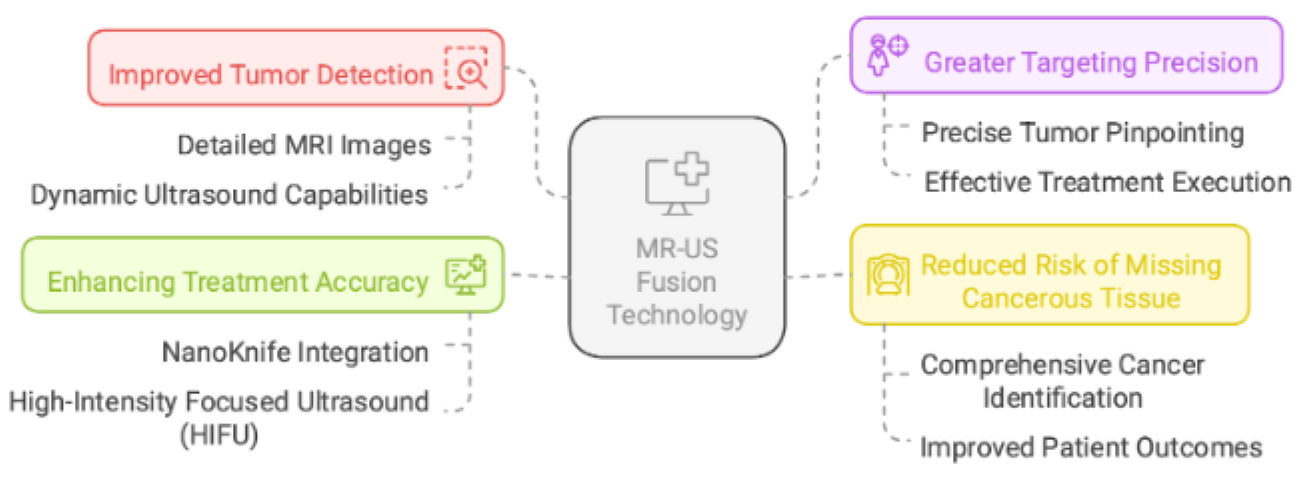
HIFU: High-intensity focused ultrasound
- HIFU uses sound waves to destroy cancer cells, targeting prostate cancer accurately.
- It is non-invasive, guided by 3D MRI and live ultrasound.
- Recovery is quick, with most patients returning home the next day.

Treatments Completed

and Erectile problems
Fast recovery
Outpatient procedure with quick recovery time (2-3 days)
Little to no side effects
Low risk of incontinence and impotence
Minimally invasive
No hormones, radiation or incisions
High-intensity focused ultrasound (HIFU) is a very successful non-invasive treatment that uses ultrasound waves to target and destroy cancerous prostate tissue with precision, sparing nearby healthy structures. It has been used clinically for more than 20 years.
At The Focal Therapy Clinic, we use state-of-the-art MRI software to precisely target cancerous tissues with HIFU. We have lowered the risk of you losing erectile function or bladder control, to help you get back to normal life.
At The Focal Therapy Clinic, our expert consultant urologists have up to 20 year’s experience in providing clinical HIFU treatments, ensuring high precision and successful patient outcomes.
Every patient case is reviewed at our weekly multidiciplinary team meeting (MDT) meeting where your case is reviewed in detail by our team of urologists, oncologists and uro-radiologist.
Our Uro-Radiologist team, led by Dr. Clare Allen, a prostate MRI and Focal Therapy pioneer, develops personalised treatment plans for each patient based on detailed review of your MRI images and biopsy results.
Learn more about how HIFU works
| Feature | HIFU |
|---|---|
| Treatment Type | Minimally invasive focal therapy |
| Energy Used | High-intensity focused ultrasound (thermal) |
| Hospital Stay | Outpatient (same day) |
| Urinary Incontinence Risk | Very low (<1%) |
| Erectile Dysfunction Risk | Low (~5-10%) |
| Repeatable Treatment? | Yes |
| Best for Tumour Location | Tumours near the base of the prostate gland |
| Suitability | Men eligible for focal therapy where tumour location is near the base of the prostate gland |
| Follow-Up Care | Regular PSA testing and occasional MRI scans |
“So I had the HIFU treatment…and the rest has been joyful and happy. I do not feel like a cancer sufferer.”
Perry Letcher
The Focal Therapy Clinic patient
Is HIFU right for me?
HIFU is a minimally-invasive treatment for men with localised, medium-to-large-volume prostate cancer in the lower part of the prostate. HIFU could be right for you if your prostate cancer is:
Early or intermediate stage
In the anterior or lateral parts of the prostate
Localised
Gleason score of 7 or lower
It could also be the right choice if you are on the NHS Active Surveillance protocol, and if you are keen to avoid long-time side effects from prostate cancer treatment.
Check your suitability
Success rates
HIFU: Advantages and Disadvantages
Advantages
- Minimally invasive - No incisions, no radiation, no hormones
- Preserves sexual function & continence - spares nerves and urinary structures
- Outpatient procedure - Go home the same day. Rapid recovery
- Repeatable if needed - Can be combined with other treatments
- Effective cancer control - equivalent to radiotherapy or surgery at 8 years
Disadvantages
- Not suitable for all prostate cancers - Advanced cases may require other treatments
- Follow-up monitoring required - Regular PSA testing and MRI scans needed.
- Risk of incomplete treatment at front of prostate - HIFU has a range of 3.0 cm from the rectum. Tumours at the front of the prostate care hard to reach.
What to Expect Before, During, and After Treatment
What to Expect Before, During, and After Treatment – Hifu
- Pre-treatment imaging (MRI/ultrasound) to pinpoint the cancer
- Blood tests (PSA levels, general health)
- Discussion of anesthesia options (general or spinal)
- Bowel preparation (as advised by your medical team)
Side effects & Risks
| Symptom | Frequency | Duration |
|---|---|---|
| Increased Urinary Frequency | Common | Usually temporary |
| Mild discomfort in perineum area | Common | 2-3 Days |
| Erectile dysfunction | Common | Usually temporary |
| Blood in urine or semen | Rare <5% | - |
| Urinary Catheter required | Rare | 3-5 Days |
| Risk of incontinence | Rare | - |
| Repeat Treatment | Sometimes | - |
Questions to ask your doctor

Are You a Good Candidate for HIFU (High-Intensity Focused Ultrasound)?
- Your cancer is intermediate risk (usually Gleason 3+4 or 4+3).
- The cancer is localised (hasn’t spread outside the prostate).
- Your PSA is under 15–20 ng/mL.
- You are expected to live at least 8–10 more years.
- The cancer is in one main spot and small enough to target.
Note: HIFU is not usually used for very low-risk or very high-risk cancer. It aims to treat the cancer while keeping side effects like incontinence or erection problems low.
"I had the HIFU procedure with Tim Dudderidge and was very happy with the results... I have absolutely no incontinence and I'm fully sexually active without any side effects."
“Focal HIFU treats cancer with lower side effects.”
HIFU is available at the Focal Therapy Clinic in the UK. It is one of the leading centres for focal therapy, including HIFU, NanoKnife, and Cryotherapy. The team includes top urologists like Mr. Tim Dudderidge, Mr Marc Laniado, Mr Raj Nigam and Mr Alan Doherty who have treated over 2,000 patients successfully.
Patient quote: "I had the HIFU procedure with Tim Dudderidge and was very happy with the results." – Graham Pipe, FTC HIFU patient.HIFU targets only the cancer, not the whole prostate. This means fewer side effects like leaking or erection problems compared to surgery or radiotherapy. NanoKnife is also precise and may preserve erections slightly better, especially in tricky cancer locations.
Patient quote: "I have absolutely no incontinence and I'm fully sexually active without any side effects." – Graham Pipe, HIFU patientSurgeon quote: "Focal HIFU kills cancer with minimal side effects. It preserves sexual function reliably." – Mr. Alan Doherty
HIFU can be safely repeated if the cancer comes back in the treated area. Studies show about 15 to 20% of men may need a second round, and it usually works well. Follow-up scans and biopsies help decide if another treatment is needed.
Urologist quote: “Focal HIFU lets us hit the cancer without harming the rest of the prostate.” – Mr. Raj NigamFor men with intermediate-risk, localized prostate cancer, HIFU has a success rate of about 88% at 5 years—meaning no need for surgery, radiation, or further treatment. Side effects are usually mild: 2% need a pad for leaks for a short time, and 90%+ men keep erections, especially if function was good before treatment.
Urologist quote: “HIFU preserves sexual function reliably.” – Mr. Alan DohertyPatient quote: “I have no incontinence and full sexual function after HIFU.” – Nigel Harris, FTC patient
- PSA tests every 3 months for the first year
- MRI scan at 12 months
- Biopsy only if the MRI scan indicates an area of concern
- Regular checks for urinary or sexual function
This helps catch any signs of cancer coming back early.
Urologist quote: “Monitoring side effects and recurrence rates is a key part of our research” – Mr. Marc LanaidoChoosing Between NanoKnife & HIFU: Key Factors
| Benefit | NanoKnife | Hifu |
|---|---|---|
| Best for Tumour Location | Irregularly shaped or near critical structures (nerves, urethra) | Well-defined tumors in specific prostate zones |
| Preservation of Nerves | No heat damage; excellent for preserving erectile function | Low risk, but heat may affect nearby structures |
| Suitability for Recurrent Cancer | Ideal for post-radiation recurrence | For tumors near the base of the prostate |
| Side Effects | Minimal impact on urinary function and sexual health | Low risk of incontinence and erectile dysfunction |
| Treatment risk | Risk of rectal injury at base of prostate | Risk of under treatment at front of prostate |
The Role of MR-US Fusion Technology in Treatment Accuracy
Benefits of MR-US Fusion Technology
- Improved Tumour Detection - More accurate than ultrasound alone
- Greater Targeting Precision - Helps specialists precisely pinpoint tumours
- Reduces Risk of Missing Cancerous Tissue - Ensures comprehensive tumour destruction

Frequently asked questions
HIFU is best for men with localized, intermediate-risk cancer (Gleason 3+4 or 4+3). It’s done as a day-case under general or spinal anaesthetic, with no cuts or stitches.
“HIFU kills cancer with minimal side effects.” – Mr. Alan Doherty
“I had the HIFU procedure… no incontinence, fully sexually active.” – Graham Pipe, FTC patient
HIFU works by heating and destroying only the cancer area, so it keeps the rest of the prostate and nearby structures safe. This helps reduce long-term side effects.
"I have no incontinence and full sexual function after HIFU." – Nigel Harris, FTC patient
“Focal HIFU treats cancer with lower side effects.” – Mr. Raj Nigam
FTC offers private care and second opinions. You can self-refer or be referred by your GP or NHS consultant. Some NHS hospitals such as Imperial Hospital or UCLH also offer HIFU, but access may be limited and varies by region.
“I had the HIFU procedure with Tim Dudderidge and was very happy with the results.” – Graham Pipe, FTC patient
If HIFU fails more than once, other treatments—like NanoKnife, surgery, or radiotherapy—are still possible. Careful follow-up with PSA tests, MRIs, and possibly another biopsy helps spot any recurrence early.
“Focal HIFU treats cancer with lower side effects and is very safe.” – Mr. Marc Laniado
“If this cures my cancer, it’s unbelievable.” – Michael Anthony, FTC HIFU patient
You should also be healthy enough to live at least 8–10 more years, and your MRI and biopsy should show a cancer spot that can be clearly targeted.
If your cancer is very low-risk, active surveillance may be better. If it’s high-risk, HIFU may not be strong enough on its own.
“HIFU kills cancer with minimal side effects.” – Mr. Alan Doherty
"I have no incontinence and full sexual function after HIFU." – Nigel Harris, FTC patient
Most recurrences happen in or near the treated area, which can be spotted early through follow-up PSA tests, MRI scans, and sometimes a biopsy.
"Ongoing monitoring of PSA is necessary after prostate cancer treatment." – Mr. Marc Laniado
Reference List
Ahmed HU et al. (2015). Focal therapy for localized prostate cancer: a systematic review of the literature. Nature Reviews Urology.
Ganzer R, Fritsche HM, Brandtner A, et al. (2017). Five-year outcome of HIFU treatment for localized prostate cancer. Urologia Internationalis.
The Focal Therapy Clinic – Prostate Cancer Treatments (Internal Resource).
NHS Resources on Prostate Cancer (Internal/External Resource).







